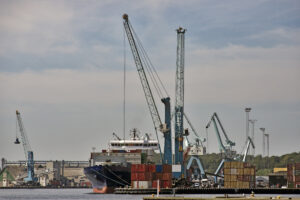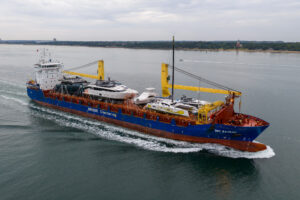The drought is impacting traffic in the Panama Canal which is progressively lowering the canal’s reservoir levels and forcing the Panama Canal to periodically manage water utilization in a sustainable manner to maintain acceptable and competitive draft levels. The current conditions, are creating an unprecedented drought, and thus far has produced the driest year on record since 1950.
The image acquired by one of the Copernicus Sentinel-2 satellites on April 14th clearly shows the water deficit in Alajuela Lake, which feeds the eastern part of the canal. The Panama Canal Authority reported a decrease of more than 10% in water levels in Alajuela from March to April, in accordance with Copernicus which is the Earth Observation component of the EU Space Programme.
The last period of intense drought in the Canal took place in 2019 – 2020. These cycles, as the canal administrator Ricaurte Vásquez Morales says, have historically happened once every five years.
“Still, what we are experiencing now is that these events are being reduced to once every three years,” he cautioned.
The Panama Canal is monitoring the development of weather events affecting water availability in the canal watershed, which according to forecasts, could worsen with the arrival of the El Niño phenomenon.
Since January 3, the canal has implemented a series of water-saving measures within its operations which will guarantee, as the canal authority claims, that ample water resources will be available to supply the population and “offer a reliable and competitive service to customers throughout the dry season,” as it is said by the authority.
The Panama Canal Authority revealed that “water saving measures will be taken by the canal during the rainy months to aid water recovery throughout the surrounding lakes and, thus, guarantee resources for human consumption without affecting transits.”
Unfortunately, current estimates indicate that the economic impact is unavoidable.
Canal Administrator Ricaurte Vásquez Morales said “procedures such as cross-fillings, cross-spilling and short chamber lockages in the Panama locks have been implemented, and increased the use of water-saving basins in the Neopanamax locks.”
He added that “additionally, we have minimized direction changes between northbound and southbound transits in Gatun locks, maximized tandem lockages, and have suspended hydroelectric power generation among other controls.”
Due to the extended drought, in advance, the Panama Canal informed its customers that based on the current and projected levels of its water reservoirs, vessels transiting the Neopanamax locks are allowed maximum drafts of up to 44.5 feet.
A limited number of ships have had to lower their draft levels to comply; notwithstanding, LNG carriers transiting through the all-water route typically report drafts of up to 37 feet, hence these temporary adjustments have had little impact on them and cero impact on ships transiting through the Panamax locks, says the Panama Canal Authority.
“This is an issue that the Panama Canal has been warning and preparing for; however, we could not have predicted exactly when the water shortage would occur to the degree that we are experiencing now,” explained Vásquez Morales.



